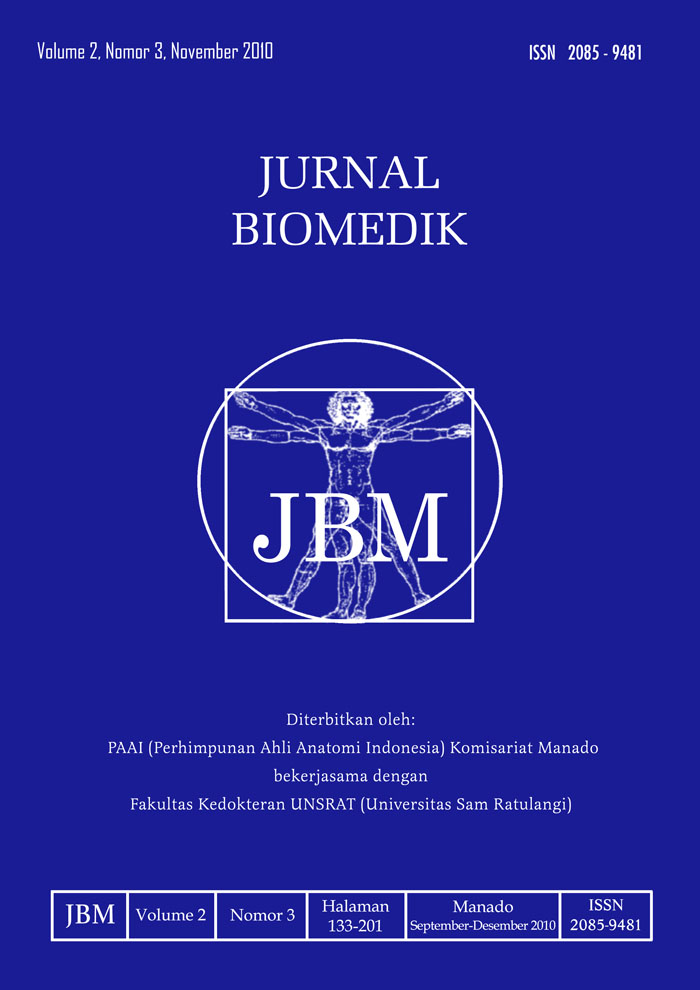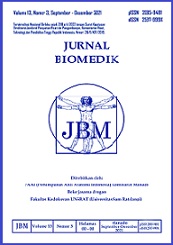HUBUNGAN ANTARA JARAK SEPTIC TANK KE SUMUR GALI DAN KANDUNGAN ESCHERICHIA COLI DALAM AIR SUMUR GALI DI KELURAHAN TUMINTING KECAMATAN TUMINTING KOTA MANADO
DOI:
https://doi.org/10.35790/jbm.2.3.2010.1197Abstract
Abstract: Water is a vital requirement for all living creatures. Standards for monitoring drinking water and clean water for other uses are rare. Besides that, water sources such as wells are contaminated by many pollutants. According to the laboratory results conducted by the Tuminting Public Health Centre, wells used in the Tuminting District, Manado, have experienced E. coli contamination. The aim of this research was to identify factors associated with E. coli in the water of wells in the Tuminting District. The method used in this research was descriptive analysis. Through interviews and checklists of wells’ owners, primary data were collected and then laboratory examinations of well-water samples were carried out. Secondary data were collected from the Health Department of Manado, and the Health Centre and the District Office of Tuminting. We used 30 water samples by simple random sampling of 67 wells. Data were analyzed through univariate and bivariate correlation tests. The results showed that E. coli in well water used by the public in the Tuminting District exceeded the standard of clean water according to the Regulations of the Ministry of Health Republic of Indonesia No.416/MENKES/PER/IX/1990 and of drinking water according to the Decree of Health Ministry No. 907/MENKES/SK/VII/2002. Moreover, there was a significant relationship between the distance of wells to septic tanks and the E. coli contents in well water. We suggest that the government improve the construction of wells and septic tanks, provide qualified water supply, and introduce the usage of chlorine to achieve clean water and a better all round health status for the Tuminting public.
Keywords : water, wells, E coli, septic tank
Â
Â
Abstrak: Air merupakan kebutuhan vital bagi semua mahluk hidup. Standar monitoring air minum maupun untuk penggunaan lainnya masih jarang. Selain itu, sumber air seperti sumur telah dicemari oleh berbagai polutan. Hasil pemeriksaan laboratorium yang dilaksanakan oleh Puskesmas Tuminting menunjukkan bahwa sumur gali di kelurahan Tuminting  telah tercemar Esherichia coli. Tujuan penelitian untuk mendapatkan faktor-faktor yang berperan terhadap pencemaran E. coli dalam air sumur kelurahan Tuminting. Metode penelitian yang digunakan yaitu deskriptif analitik. Data primer dikumpulkan melalui wawancara dengan pemilik sumur gali dengan menggunakan check list, dilanjutkan dengan pemeriksaan laboratorium terhadap sampel air sumur gali. Data sekunder diambil dari Dinas Kesehatan Kota Manado serta Puskesmas Tuminting dan Kantor Kelurahan Tuminting. Sampel ditentukan dengan metode simple random dan diperoleh 30 sampel air dari 67 sumur gali. Data dianalisis secara univariat dan bivariat dengan menggunakan uji korelasi. Hasil penelitian menunjukkan bahwa kandungan E. coli dalam air sumur gali yang digunakan oleh masyarakat di Kelurahan Tuminting melebihi standar baku mutu air bersih sesuai dengan Peraturan Menteri Kesehatan RI Nomor 416/MENKES/PER/IX/1990 maupun dari air minum sesuai dengan Keputusan Menteri Kesehatan RI Nomor 907/MENKES/SK/VII/2002. Selain itu terdapat hubungan yang bermakna antara jarak sumur gali ke septic tank dan kandungan E. Coli dalam air sumur gali. Disarankan kepada pihak pemerintah daerah untuk melakukan perbaikan konstruksi sumur gali maupun septic tank, menyediakan air bersih yang memenuhi syarat kesehatan, dan sosialisasi kepada masyarakat tentang penggunaan air bersih dan kaporisasi.
Kata Kunci: air, sumur gali, Â E. coli, septic tank
Downloads
Issue
Section
License
Penyunting menerima sumbangan tulisan yang BELUM PERNAH diterbitkan dalam media lain. Naskah yang masuk dievaluasi dan disunting keseragaman format istilah dan cara penulisan sesuai dengan format penulisan yang terlampir dalam jurnal ini.
Segala isi dan permasalahan mengenai tulisan yang yang diterbitkan dalam jurnal menjadi tanggung jawab penuh dari penulis.







